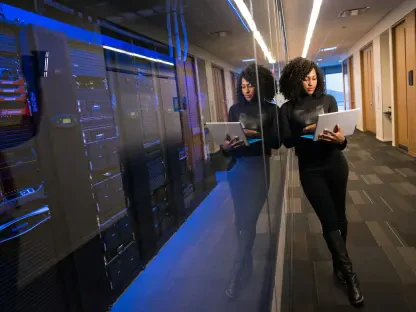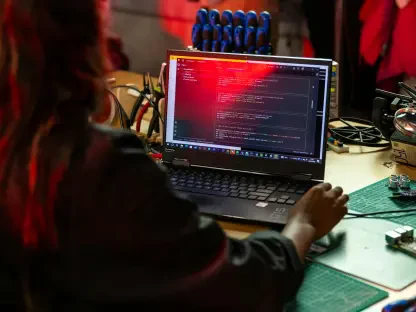The automotive industry is undergoing a revolutionary transition with the advent of software-defined vehicles (SDVs), requiring a new approach to product development and ownership. This shift emphasizes the importance of a collaborative ecosystem to manage the technological complexities associated with SDVs, fostering a dynamic and innovative industry landscape.
Challenges in Transitioning to SDVs
Start-ups vs. Established Automakers
Start-ups and established automakers face distinct challenges in moving towards SDVs, each contending with unique constraints and opportunities. Start-ups, unfettered by legacy technology constraints, are free to innovate without the burden of existing systems. This clean slate enables them to design cutting-edge vehicles from the ground up, incorporating the latest technologies without the need to integrate older systems. In contrast, established automakers must find innovative and cost-effective solutions to design new architectures while maintaining their existing systems. Balancing the integration of new technologies with legacy systems presents a formidable challenge, necessitating a phased approach to ensure a seamless transition while safeguarding existing investments.
This transition extends beyond technological hurdles and necessitates a fundamental shift in mindset. Unlike traditional vehicles, which remain relatively unchanged after production, SDVs are expected to evolve over time. This evolution demands that original equipment manufacturers (OEMs) create adaptable products capable of continuous enhancement through software updates. Such flexibility transforms vehicles from static assets into dynamic entities that grow with their owners, constantly improving in response to new developments and customer needs. The shift in mindset is crucial, as it redefines the entire lifecycle of vehicles, fostering a culture of continuous innovation and improvement.
Balancing Hardware and Software
Derek de Bono, Head of SDV at Valeo, emphasizes the importance of balancing unchanging hardware with constantly updated software to achieve the dream of a car that evolves with its customer. This balance is crucial for enduring vehicle evolution, laying the foundation for transformations that keep pace with technological advancements. De Bono highlights that no single company can manage the transition to SDVs alone, underscoring the necessity of an ecosystem of partners, each bringing specialized expertise across various domains. From AUTOSAR systems and system-on-chips to in-vehicle infotainment, success hinges on fostering agile, collaborative, and fast-paced working environments.
The collaborative approach inherent in SDV development centers on the principle that hardware remains stable while software evolves. This decoupling of hardware and software enables continuous enhancements without frequent hardware changes, ensuring long-term scalability. By focusing on modular hardware designs and robust software platforms, OEMs can achieve greater efficiency and flexibility in their development processes. De Bono’s vision encapsulates the essence of SDV ecosystems, advocating for inter-company collaboration to overcome complex challenges and achieve sustained innovation. Embracing this ecosystem approach is paramount to realizing the full potential of SDVs and their transformative impact on the automotive industry.
The Necessity of a Collaborative Ecosystem
Redistributing Ownership
Traditionally, automakers have maintained consolidated ownership of delivery processes, tightly controlling every aspect from design to production. However, the development of SDVs requires redistributing this ownership across an ecosystem of partners. Automakers must collaborate with multiple stakeholders to ensure timely market entry and adherence to quality standards expected by customers. This shift from a siloed to a collaborative model is essential for managing the complexity and scope of SDV projects. By leveraging the strengths of various partners, automakers can tap into specialized expertise, accelerate innovation, and deliver superior products to market.
The necessity of a collaborative ecosystem is underscored by the intricacy of SDV development, which demands a confluence of technologies and capabilities. From software developers and hardware manufacturers to connectivity providers and cloud service experts, each partner plays a crucial role in the SDV ecosystem. Redistributing ownership allows automakers to harness the collective intelligence and resources of their partners, driving innovation and efficiency. This approach also fosters a culture of shared responsibility and mutual growth, where success is measured by the collective achievements of the ecosystem as a whole. Collaboration becomes the linchpin of SDV development, enabling the automotive industry to navigate the complexities of this technological revolution.
Partner Ecosystem Example: Renault
Renault’s mainstream SDV platform, announced in May 2023, exemplifies the significance of creating a partner ecosystem. This initiative involves multiple partners, including Valeo, which brings a diversified portfolio encompassing both hardware and software. With 30 years of experience in the software domain, Valeo is shifting focus to showcase its capabilities in software development alongside hardware provision. Renault’s example illustrates the collaborative spirit required to drive SDV innovation, demonstrating how automakers and partners can work together to achieve common goals.
The Renault platform highlights the importance of leveraging the collective strengths of multiple partners. By partnering with tech giants like Google and Qualcomm, Renault aims to supply high-performance computing hardware and essential components and services. This collaboration underscores the value of an ecosystem approach, where each partner contributes its unique expertise to achieve a common objective. Valeo’s comprehensive range of competencies, encapsulated in its ‘Valeo anSWer’ portfolio, positions it as a key player in this ecosystem. This diverse offering allows Valeo to align with major industry milestones and support Renault’s ambition to make SDV architectures accessible beyond the premium vehicle market.
Decoupling Hardware from Software
Creating Enduring Value
One of the key themes in SDV development is the decoupling of hardware from software to create enduring value. Product lifecycles must adapt to ensure the long-term safety, stability, and relevance of vehicles in an ever-evolving technological landscape. This adaptation requires a new understanding of how changing software and unchanging hardware coexist seamlessly. By maintaining stable hardware platforms and introducing incremental software enhancements, automakers can extend the lifecycle of their products, ensuring they remain relevant and competitive over time.
Partner ecosystems must also remain agile, ready to switch roles as projects evolve. For instance, Valeo might initially provide hardware and later integrate or validate software stacks from various sources, catering to the diverse needs of each project. This dynamic approach allows for greater flexibility and responsiveness to changing market demands. The ability to pivot and reassess roles ensures that partners can collaboratively navigate the complexities of SDV development, continually optimizing processes and delivering value. The decoupling of hardware and software represents a fundamental shift in automotive manufacturing, emphasizing adaptability and long-term innovation.
Valeo’s Comprehensive Competencies
Valeo’s comprehensive range of competencies positions it as a key player in the SDV ecosystem, capable of delivering both hardware and software solutions. Encapsulated in its ‘Valeo anSWer’ portfolio, this diverse offering includes applications, middleware, and services, enabling seamless integration of various components. By aligning with major industry milestones such as Renault’s goal of developing a mainstream SDV platform, Valeo demonstrates its commitment to driving SDV innovation at scale. Collaborating with tech giants like Google and Qualcomm, Valeo aims to supply high-performance computing hardware and other essential components and services, supporting Renault’s ambition to make SDV architectures accessible beyond the premium vehicle market.
Valeo’s commitment to comprehensive solutions extends to its ability to adapt and pivot based on project needs. By offering a combination of hardware and software capabilities, Valeo ensures that its partners have access to the full spectrum of tools required for successful SDV development. This holistic approach underscores the importance of collaboration and agility in the rapidly evolving landscape of automotive innovation. Valeo’s competencies not only contribute to individual projects but also set a benchmark for industry standards, fostering a culture of excellence and continuous improvement that drives the entire SDV ecosystem forward.
Redefining Value in the OEM-Partner Ecosystem
Collaborative Development Models
SDVs redefine the concept of value within the OEM-partner ecosystem by fostering collaborative development models. Through partnerships with companies like BMW, Valeo is delivering new domain controllers in partnership with Qualcomm, sensor sets, and a parking stack. This collaborative effort is instrumental in advancing SAE Level 4 valet parking, leveraging aggregated cloud data from vehicle sensors to produce crowdsourced maps. This model represents a fundamental shift in ownership paradigms, with partners co-developing and co-owning intellectual property rather than suppliers merely delivering for OEMs.
Collaborative development models highlight the benefits of shared innovation and resources. By working together, partners can pool their expertise and drive advancements that would be challenging to achieve independently. This approach also promotes greater transparency and trust within the ecosystem, as partners work towards common goals and share in the success. The shift towards collaborative ownership not only accelerates the pace of innovation but also enhances the quality and reliability of SDVs. By embracing this model, the automotive industry can harness the collective potential of its ecosystem, driving transformative change and delivering exceptional value to customers.
Economic Implications and Cost-Saving Strategies
The economic implications of SDVs are significant, particularly the high initial investment costs. Modern vehicles, equipped with 50 to 150 ECUs and complex wiring harnesses, are costly. However, simplifying the architecture over time can reduce ECU numbers, generating savings and creating space for additional hardware and functions essential for the SDV ethos. This cost-saving strategy supports the long-term evolution of vehicles in line with consumer demands. By carefully managing the balance between initial investments and long-term savings, automakers can create a sustainable financial model for SDV development.
Cost-saving strategies also involve optimizing resources and processes to maximize efficiency. By streamlining development cycles and leveraging the benefits of modular design, automakers can reduce redundancies and improve overall productivity. This approach not only lowers costs but also enhances the agility and responsiveness of the development process. Investing in scalable and flexible architectures ensures that vehicles can be continuously upgraded and improved, delivering lasting value to customers. The economic benefits of these strategies extend beyond immediate savings, contributing to the overall sustainability and competitiveness of the automotive industry in the SDV era.
The Financial Model of SDVs
Pay to Unlock Business Model
To make the financial model of SDVs viable, De Bono supports the ‘pay to unlock’ business model. This approach generates long-term value by allowing customers to access new features and functionalities through over-the-air software updates. This model justifies the high initial investments by automakers, as it creates a recurring revenue stream that sustains ongoing development and innovation. By saving on unseen aspects like architecture, OEMs can allocate resources towards more hardware, subsequently enhanced through software updates. De Bono anticipates that the first wave of SDV products capturing this opportunity will arrive in the market within the next 18-24 months.
The ‘pay to unlock’ model also aligns with the evolving consumer expectations for personalized and adaptable vehicles. Customers can tailor their vehicles to suit their changing needs and preferences, accessing new features without the need for physical modifications. This level of customization enhances the overall ownership experience, fostering greater customer loyalty and satisfaction. The model also provides a platform for continuous engagement between OEMs and customers, fostering a dynamic and interactive relationship. By embracing this financial model, the automotive industry can create a sustainable and innovative approach to SDV development, delivering lasting value to both manufacturers and customers.
Practical Examples of SDV Upgrades
The automotive industry is experiencing a groundbreaking transformation with the emergence of software-defined vehicles (SDVs). This evolution necessitates a fresh perspective on both product development and vehicle ownership. Unlike traditional cars, SDVs rely heavily on sophisticated software systems for functionality, requiring car makers to integrate advanced technology and data management systems. This new approach demands a collaborative ecosystem, bringing together automakers, tech companies, and other stakeholders to tackle the technological challenges inherent in SDVs.
By fostering a cooperative environment, the industry can navigate the complexities and rapidly changing landscape of software-driven vehicles. This sense of collaboration is essential for innovation, allowing for continuous improvements and agile responses to emerging technologies and market demands. The transition to SDVs represents not just a shift in vehicle design but a broader change in how companies within the automotive sector interact and operate, signaling a dynamic and innovative future for the industry.









